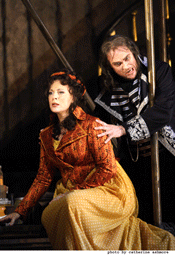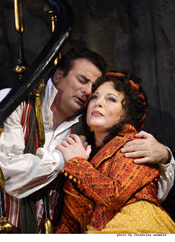12 Jun 2011
Tosca, Covent Garden
The current Tosca at the Royal Opera House is something of a classic, revived four times in five years. It’s now being filmed for cinema to be released in November 2011.

The current Tosca at the Royal Opera House is something of a classic, revived four times in five years. It’s now being filmed for cinema to be released in November 2011.
The film will feature Angela Gheorghiu, Bryn Terfel and Jonas Kaufmann, all of whom have sung in this production before — Gheorghiu and Terfel together in 2006 and 2009, and Kaufmann for the first time in 2008.
The current season started, however, with an alternate cast — Marcelo Giordano, Juha Uusitalo and Martina Serafin. Giordano sang Cavaradossi in 2006, and with Gheorghiu and Terfel in 2009, so he’s experienced in the role. On the first night of the run, he had intonation problems to start with, but settled well, only to have his voice break badly in the crucial Act Three arias. No-one regrets it more than the singer himself, when “E muoio disperato!” comes out more desperate than it should be. But such things happen, even to very experienced singers. In any case, this audience didn’t seem to mind and applauded him warmly. Tosca is such a glorious opera that it’s always a good night out even when it’s not perfect.
 Martina Serafin as Tosca and Juha Uusitalo as Scarpia
Martina Serafin as Tosca and Juha Uusitalo as Scarpia
Juha Uusitalo was making his Royal Opera House debut, though he’s appeared all over Europe and in the US, and in concert performances in London. His Scarpia is interesting, more subtle and introspective than some, but that’s a perfectly valid interpretation of the role. Tosca wears her heart on her sleeve, but Scarpia has risen to power by concealing his. Scarpia is a cold-blooded hunter who doesn’t reveal himself, but Uusitalo’s tightly controlled phrases and brisk intonation suggest the tension that might lie within the charcater.He’s so used to being in command that he can silence the commotion in church by a swift glance and a sarcastic phrase “Bel rispetto!”. Uusitalo ‘s stage presence carries authority even when he’s not singing.
Martina Serafin has created Tosca in Vienna, Rome and Taormina. She’s charming and the London audience delighted in her coquettish Act One jealousy. Tosca, however, is a much more complex personality, and the jealousy can be a glimpse of much greater violence in the character. Whether it’s Serafin or the revival direction (Duncan Macfarlane) the murder scene is a curious anticlimax. The orchestra wells up, as the music’s expressing extreme alarm. Serafin leans against Uusitalio, but so politely that if you didn’t know, you’d wonder why he drops to the ground in agony.
In contrast, Jeremy White’s Sacristan was very animated, reflecting the subtle changes in mood as the Sacristan interacts with different people. As whole mayhem breaks out around him, the Sacristan is anchored, sensitive to others, but sensible. Another contrast to Tosca, but without Scarpia’s menace,
 Marcello Giordani as Cavaradossi and Martina Serafin as Tosca
Marcello Giordani as Cavaradossi and Martina Serafin as Tosca
Hubert Francis’s Spoletta worked well with Uusitalo’s discreet Scarpia. Angelotti was Lukas Jakobski and Sciarrone was Zhengzhong Zhou, both members of the Jette Parker Young Artists Programme. The Shepherd Boy, William Payne, was a delight.
Usually, Antonio Pappano’s Puccini is superb, as he has the Puccini spirit in his soul, but at the first night performance even his irrepressible energy seemed to have deserted him. Just as the direction on stage seemed lifeless, the orchestral playing sounded like a rehearsal. Nonetheless, Pappano and the Royal Opera House orchestra are very good even when under par. In other houses this would have been fine, but we’re so used to excellence that average doesn’t excite.
One compensation was that it was an opportunity to study the scenery, which you can’t when performances are white hot. The scene in the church is brightly lit, with candles everywhere. On stage, attention is dissipated, but the scene could film well. Scarpia’s chambers reflect the grandeur of his status. Magnificent statues dwarf the singers, just as the opulence of the music shows up the tawdry proceedings in the plot.
The Final Act is most impressive of all. Gone are the trappings of worldly splendour. Cavaradossi now inhabits a stark no man’s land. The music gets to work its sinister magic without distraction. A man is seen getting dressed. He looks human and vulnerable, but when he’s in uniform he becomes a killing machine. The set is plain, but eloquent, for now there’s no room for manoeuvre. Even if Cavaradossi escaped, he wouldn’t be safe when news gets out of Scarpia’s death. Poor Tosca goes off the wall, in more ways than the obvious.
Tosca runs at the Royal Opera House, London until 17th July. Filming with the second cast starts on 14th July. For more information please see the Royal Opera House site.
Anne Ozorio